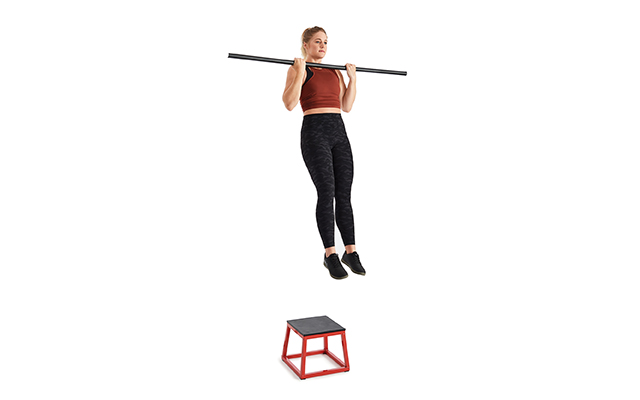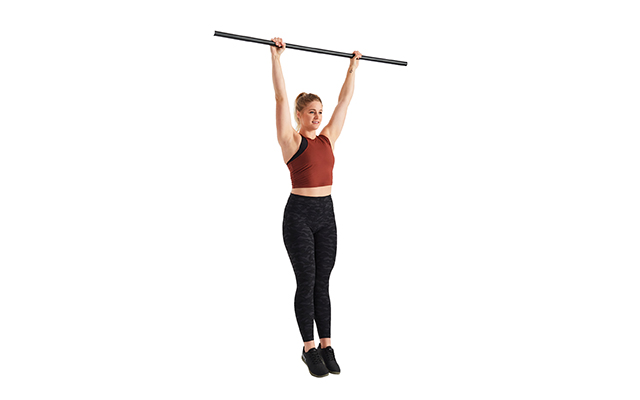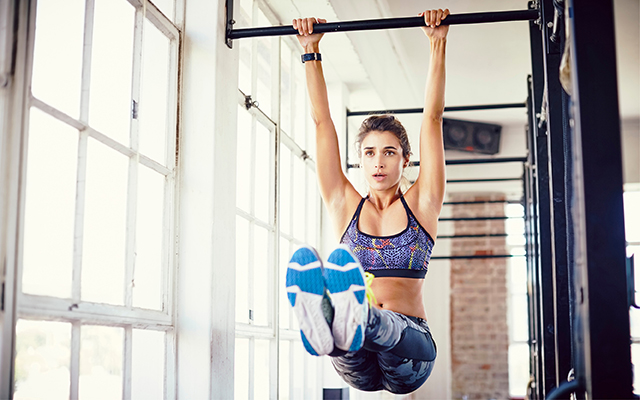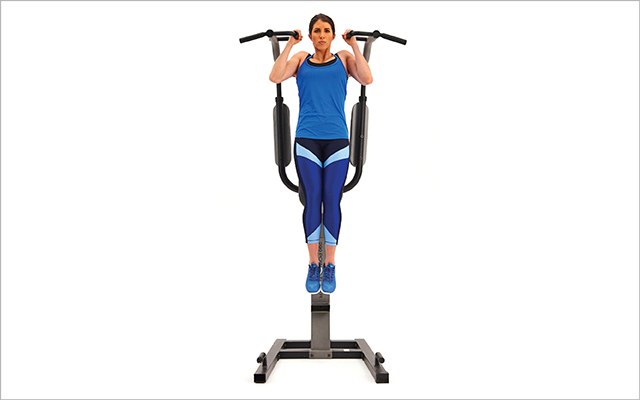Pull-ups are tough, no matter how strong you are. In addition to the physical challenge, they also present a mental one: “Many people have a block that says, ‘I can’t do them,’” says Mikey Mueller, NASM-CPT, USAW, Alpha Coach at Life Time.
But working to overcome both the physical and mental challenges is well worth the effort. Pull-ups are among the best exercises for the upper body’s “pulling” muscles — notably the latissimus dorsi (on the sides of the torso), trapezius (midback), and biceps (upper arms). These interrelated muscle groups are essential for carrying, climbing, rowing, and lifting anything off the ground.
Exercises for these areas counterbalance all the pushups and presses that form the bulk of many exercise routines, helping to ensure better posture and shoulder health.
In addition to offering functional benefits, pull-ups are undeniably cool. When you finally hoist your body weight to that overhead bar, there’s a deep sense of satisfaction.
“Seeing someone achieve their first pull-up is a highlight in my career,” says Mueller. “It’s a great physical and mental victory.”
This 30-day program created by Mueller will help you get your chin over the bar.
The Workout
Do these moves three times a week on nonconsecutive days (Monday, Wednesday, and Friday, for example) for four weeks, building in volume over the month as indicated in the table below.
Perform the exercises marked with the same letter as supersets, with 30 to 45 seconds of rest between moves. For the first pair of exercises (A1 and A2) in the second week, for example, perform one static chin-up hold to fatigue, then rest for 30 to 45 seconds. Next, do a set of eight to 12 scapular pull-ups, rest again, and repeat two cycles of the A exercises. Then do the same for the B and C moves.
|
Week |
Exercises | Sets |
|
1 |
A1, A2
B1, B2 C1, C2 |
2 1 1 |
|
2 |
A1, A2
B1, B2 C1, C2 |
2 2 2 |
|
3 |
A1, A2
B1, B2 C1, C2 |
3 2 2 |
| 4
|
A1, A2
B1, B2 C1, C2 |
3 2 3 |
Mix Up Your Grip
There are a variety of grip options worth trying on your pull-up journey — and some may seem easier than others. Experiment with the different grips below to find which suits your unique physiology, strength, and mobility. Vary the grips from workout to workout, if you like, while building strength and avoiding pain from overusing one particular grip.

The Moves
A1: Static Chin-Up Hold

- Standing on a bench or box, take a chin-up grip on the bar.
- Jump to the “up” position — chin over the bar — and hold yourself there.
- Lower yourself when you feel fatigued but not exhausted; your effort level should be 80 percent, or about a four out of five.
A2: Scapular Pull-Up
- Take an overhand pull-up grip on the bar and hang from it.
- Keeping your arms straight, pull your shoulders away from your ears and your shoulder blades toward your waist (think of performing the reverse of a shrugging movement).
- Slowly reverse the move, returning to the dead-hang position.
- Repeat for a total of eight to 12 repetitions.
B1: Pull-up Negative
- Standing on a box beneath the bar, jump to the “up” position.
- Lower yourself back to the starting position as slowly as possible, aiming for a five- to 10-second descent.
- Repeat for three to five repetitions.
B2: One-Arm Bent-Over Lat Stretch

- Stand with your feet apart, facing a railing, barbell rack, or other sturdy, waist-high object.
- Hold the railing with your right hand. Place left hand on your hip or let it hang at your side.
- Keeping your hips and shoulders square and your right arm straight, bend forward until your torso and right arm are parallel to the floor and you feel a stretch along the right side of your torso.
- Hold for 20 to 30 seconds and repeat on the other side.
C1: TRX or Ring Row
- Holding the handles of a TRX (or equivalent suspension trainer) with your palms toward each other, lean back until your body forms a 45-degree angle with the floor.
- Keeping your body in a straight line from your head to your heels, draw your shoulder blades together and pull your elbows backward as far as possible.
- Hold for one count, then slowly return to the starting position and repeat the move for a total of eight to 12 reps.
Make it easier: Walk your feet back and perform the move with your body in a more upright position.
Make it harder: Perform the exercise with your feet elevated on a 12-inch box or step.
C2: Active Hang

- Using an overhand, shoulder-width grip, hang from the chin-up bar for 30 to 90 seconds, keeping shoulders pulled away from your ears and shoulder blades pulled toward your waist.
Pull-Up Mastery
Just got your first pull-up? Shooting for five, or 10, or 20? The primary technique for building up your reps, explains Mikey Mueller, NASM-CPT, USAW, Alpha Coach at Life Time, is called greasing the groove — essentially performing perfect single reps throughout your day, as often as you are able. There are a number of ways to get this done.
One is by installing a pull-up bar in a high-traffic doorway at home or work. No-drill units are lightweight and can be easily slipped into an average doorway. Once it’s set up, do single reps, whenever you can, three to 10 times a day, or whenever you pass under the bar (consider it the athlete’s mistletoe). Because you’re doing only one rep, and resting sometimes hours between attempts, he says, “fatigue isn’t a factor.”
When you’re out and about, be on the lookout for convenient scaffolding, overhead landings, and low-hanging tree branches where you can quickly knock out a rep or two. “You won’t add time to your workouts,” he says, “but you’ll get a lot of reps in.”
Similarly, when you’re at the gym, do a single rep when you arrive, and a single rep at convenient intervals throughout your workout. If you’re doing a cardio workout, perform a pull-up whenever you hit the water fountain; if it’s a leg workout, do a rep after every three to four sets. You’ll easily amass four to 10 mini-sets each time you go to the gym. That adds up.
After a while, you’ll be able to get two reps on your first set, then two on your first two sets, and finally, two reps on all four to seven sets, at which point you can start building to three reps on all sets, then four, and so on. The table below shows how you might progress in the first month after you’ve conquered that all-important first rep.
|
Week |
Reps in Set 1 | Reps in Set 2 | Reps in Set 3 | Reps in Set 4 |
Reps in Set 5 |
|
1 |
1 | 1 | 1 | 1 | 0 |
|
2 |
2 | 2 | 1 | 1 |
1 |
|
3 |
2 | 2 | 2 | 2 |
2 |
|
4 |
3 | 2 | 1 | 1 |
1 |
This originally appeared as “Get Your First Pull-Up” in the November 2018 print issue of Experience Life.




This Post Has 0 Comments